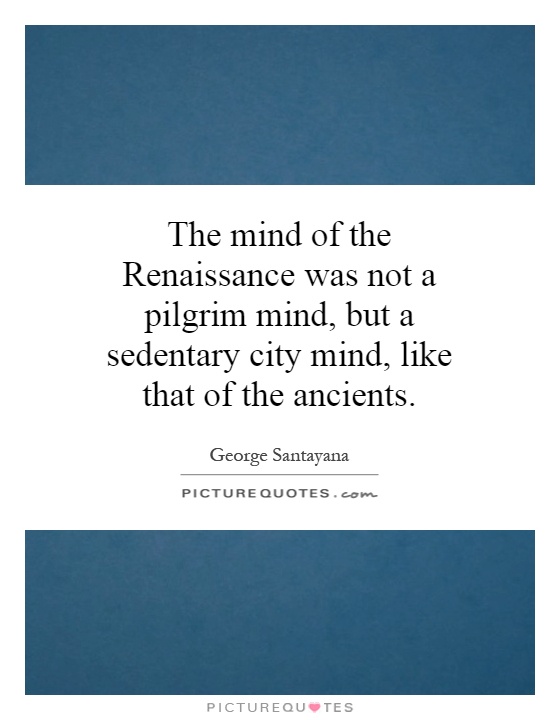The mind of the Renaissance was not a pilgrim mind, but a sedentary city mind, like that of the ancients

The mind of the Renaissance was not a pilgrim mind, but a sedentary city mind, like that of the ancients
George Santayana, a Spanish-American philosopher, poet, and novelist, was known for his insightful observations on human nature and the evolution of thought throughout history. In his work, Santayana often explored the intellectual climate of different time periods, including the Renaissance. One of his notable statements about the Renaissance was that "The mind of the Renaissance was not a pilgrim mind, but a sedentary city mind, like that of the ancients."This statement reflects Santayana's belief that the intellectual culture of the Renaissance was characterized by a sense of rootedness and stability, rather than a restless quest for new knowledge and experiences. In contrast to the medieval period, which was marked by a preoccupation with spiritual pilgrimage and the search for divine truth, the Renaissance was a time of urbanization, trade, and cultural exchange. The cities of Italy, in particular, became centers of learning, art, and commerce, attracting scholars, artists, and merchants from across Europe.
Santayana's comparison of the Renaissance mind to that of the ancients is significant because it highlights the revival of classical learning and values during this period. The Renaissance was a time of rediscovery and reevaluation of ancient Greek and Roman texts, art, and philosophy. Scholars like Petrarch and Erasmus sought to emulate the wisdom and achievements of the ancient world, while artists like Leonardo da Vinci and Michelangelo drew inspiration from classical forms and themes.
At the same time, Santayana's characterization of the Renaissance mind as "sedentary" suggests a certain complacency or conservatism in the intellectual attitudes of the time. While the Renaissance was a period of great innovation and creativity, it was also a time of political and religious upheaval, with the Protestant Reformation challenging the authority of the Catholic Church and the rise of humanism questioning traditional beliefs and values.
Overall, Santayana's observation about the Renaissance mind offers a nuanced perspective on the intellectual climate of the time, highlighting both its continuity with the past and its potential for change and progress. By recognizing the influence of ancient thought and the urban environment on Renaissance culture, Santayana invites us to consider the complex interplay of tradition and innovation in shaping human consciousness.












 Friendship Quotes
Friendship Quotes Love Quotes
Love Quotes Life Quotes
Life Quotes Funny Quotes
Funny Quotes Motivational Quotes
Motivational Quotes Inspirational Quotes
Inspirational Quotes